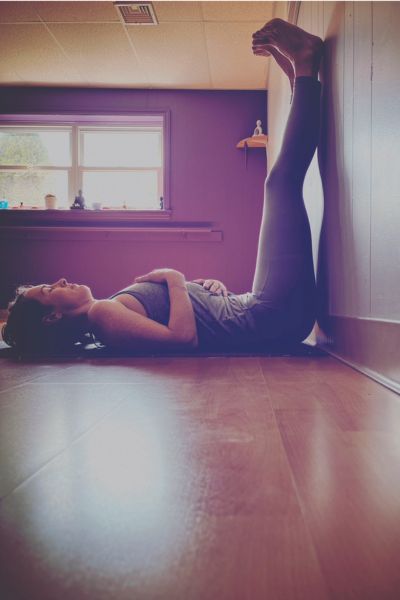I stumbled across an email announcement for yoga teacher training while unapologetically hiding from my kids. The training was in a neighbouring town, scheduled on a day that I didn’t have to work and my husband could be a solo parent, and there were only a few spots left. Call it intuition or a need to throw myself into something completely my own, I felt an overwhelming urge to claim a spot right then. I waited maybe 24 hours before signing up and dusting off a used copy of the Bhagavad Gita.
If I had one, the plan was not to end up actually teaching yoga. I already had a full-time gig as a college professor. I love teaching, but I did enough of it. Yoga was my self-care go-to that I wished to keep to myself. Plus my husband and I were still deep in the trenches of parenting our little kids. A new commitment like teaching yoga was just too big to squeeze into my packed life. Teacher training was exciting because it was a short-term way to revitalise my practice and give it new meaning. Maybe I’d also make a friend or two.
Six months of teacher training did bring all of the above and, (un)surprisingly, a call to teach that I could not ignore. At first, I taught one class a week to feel out if teaching was the right fit. With every class I taught though, I fell more and more in love with the art of teaching yoga. Teaching didn’t replace my own practice, but it was a sweet complement to the work I did on my own mat. In one year, my yoga business has grown to teaching at least three studio classes a week, hosting events and retreats, and writing about all things yoga.
If it appears magical, trust that going all in with a yoga business has not been only sparkles and sunshine. In my 12 years coming to the mat as a student I was blissfully unaware of what it took to be a yoga teacher. It seemed like a very fun job with perks, like wearing cute leggings to work. The realities of being a yoga teacher, however — and a new one at that — only come to the surface when we are living them ourselves.
These are the five most surprising realisations of my first year teaching yoga:
1. It's not about the teacher
In reality, it is all about the students. I used to idolise my yoga teachers as if they were super-humans who were kind enough to share their wisdom. In reality, most teachers are just trying to figure out how to help their students feel better than they did before class. Although they may, students are not there to brighten our day or applaud our teaching. They are there for themselves and we are there for them. A teacher’s relationship to their teaching cannot be dependent upon whether students say hello or thank you, smile, make conversation, keep to themselves, or quietly disappear out the door after class. Most of the time, how students behave in class is about them and whatever is circling around in their lives at the moment.

2. Trust is earned
Having the teaching certification in hand and landing a spot on the studio’s schedule are only the very start of the work. Students gravitate toward teachers they trust. It takes time, effort and constant showing up to foster trusting social connections. Some students hesitate or even downright refuse to take a class with a new teacher. Their trust may have to be built through interactions in classes taught by other teachers, in the studio lobby, and on social media. This can mean being present and available as a teacher even when we are off the clock.
3. The anxiety in the first year is real, but it subsides
I’ve heard yoga teachers being praised for being forever calm and grounded, but in my first year of teaching yoga the anxiety was off the charts. I worried about getting the inspiration for new sequences, the number of students showing up to class, whether the studio would keep me on the schedule or not, stumbling over my words and forgetting my cues, and on and on and on. If yoga philosophy teaches us to calm the mind and make peace with acceptance, the start of a teaching career is the true test of these practices. The good news is that the anxiety does subside over time. My feelings of uneasiness have slowly blossomed into confidence, self-love
and gratitude for my gifts as a teacher.

4. Extraversion is required
There is little room to be shy in the business of yoga. At my core, I am an introvert needing ample quiet time devoid of social interactions. Before becoming a teacher, I would sneak in and out of class with only an exchange of hello and thank you. I would sit on the sidelines of post-class conversations weaving my way around chatty yogis to find the fastest way out the door. That is okay for a student, but not a teacher. Teachers have to get comfortable with being seen and heard often, initiating and keeping conversations, and making social connections among students.
5. Teachers are their best advocates
There are mentors, clients and colleagues of course, but the best advocate of a yoga business is the owner themselves. We may be tempted to rely on the optimistic belief that opportunities will come to us because we are good teachers, and sometimes this is true. But more often, new opportunities become a reality through intentionally taking steps to bring them into fruition. If we want to teach a class, get more client reviews, run an event, or have any new opportunity that will propel a yoga business forward, then we have to step into the driver’s seat to make it happen.
It took me an entire year of teaching to come to these realisations. I wish I had known of them as a student though. It would not have deterred me from signing up for yoga teacher training or starting a yoga business, but rather, it would have given me a more enlightened sense of gratitude and appreciation for my teachers.
Brandi Rima is a vinyasa and restorative instructor (RYT-200) and professor of Applied Social Psychology at Bronx Community College of the City University of New York. She lives in Montclair, NJ with her husband James, four children Joe, Nick, Genevieve and Gemma, and two dogs Ziggy and Betty. Find her at: privateyogamtcnj.com or connect on IG @rimabirdyoga





